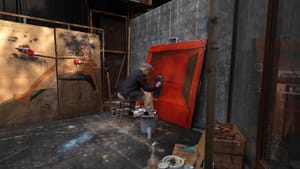Stay in the Loop
BSR publishes on a weekly schedule, with an email newsletter every Wednesday and Thursday morning. There’s no paywall, and subscribing is always free.
David Lynch, film artist
David Lynch's Unified Field at PAFA

When I told my son I had been in the presence of filmmaker David Lynch, he asked, “Was he strange?” “No,” I said. “Actually, he was charming.” Except for the splash of stand-up white hair, David Lynch’s look is traditional: a charcoal shade suit, an open collar white shirt, and nice black shoes. Seated in a chair, he seemed relaxed — smiling, eyes bright — even as his expressive hands gestured to and fro, returning to a place of rest in his lap.
He was speaking — or rather he was being interviewed — at the main branch of the Free Library, which is where I saw him. He was in Philadelphia for the opening of an exhibit, The Unified Field, of his paintings from 1966 to today at the Pennsylvania Academy of the Fine Arts (PAFA).
David Lynch is not a stranger to Philadelphia. This is where he went to school, at PAFA to study art and painting, almost 50 years ago. He told the Free Library audience that since childhood, once he found out that an adult could be a painter of pictures and not just a painter of houses, he wanted to be a visual artist. It was also in Philadelphia that he “got the idea for a moving picture.”
Pictures that move
As he explained, one night while working on a painting of a garden, he stopped to have a look and saw something come out of the painting making a sound like the wind and the plants in the painting began to move around. The vision, or as he would prefer, the dreamlike actuality, provoked in him a desire to make pictures that move. He now defines cinema as “sound and picture moving together in time.”
 David Lynch then made his first film, 60 seconds long, titled Six Men Getting Sick (Six Times), for which he shared first prize (with someone else’s painting) in PAFA’s annual end-of-year showcase of student work. The film is running on a loop in the current PAFA exhibit.
David Lynch then made his first film, 60 seconds long, titled Six Men Getting Sick (Six Times), for which he shared first prize (with someone else’s painting) in PAFA’s annual end-of-year showcase of student work. The film is running on a loop in the current PAFA exhibit.
Likewise, Philadelphia offered David Lynch his distinctive — or, some would say, peculiar — subject matter for films to come. In the late 1960s, together with his new wife and their baby girl, he was living in a large house they bought cheaply in the Fairmount section. Three days after moving in, their house was broken into. A young person was murdered on their block; they were robbed a second time and on another occasion the windows of their house were shot out; they had a car stolen; altogether, it was a high-anxiety neighborhood with violence, poverty, and dirt.
He felt fear, and he felt the closeness of extreme danger. His experience of living in Philadelphia, he said, was the biggest influence on his whole artistic life, beginning with the mood of horror put into Eraserhead, which he called his very own Philadelphia Story.
Shrinking visions
Mr. Lynch shared his “huge sadness” about cultural change: that art films have moved from art cinema houses to cable TV. He laments the loss of visual size or scale — the images we view on screens and monitors at home are little. This littleness runs contrary to the job of a filmmaker, which is “to build a film to fill a room” with moving pictures and sound. It seems to him as though art film at the cinema is on the endangered culture list.
An audience member asked Mr. Lynch how he had created the role of Gordon Cole on Twin Peaks. He answered that it had to do with arriving on the set and for some reason talking loudly, which turned FBI agent Cole into a hard-of-hearing person. While asserting he isn’t an actor, he said he was glad to do the role because he got to kiss Sheryl Lee, the actress who played Laura Palmer.
 Hello?
Hello?
At PAFA through January, The Unified Field offers more than 90 of David Lynch’s deeply dark-toned, mostly surrealistic paintings and drawings. I attended the packed opening on September 12, and although it was cumbersome to try to see through the crowd of wonderfully dressed persons filling the galleries, I saw enough to make my heart sink. Two drawings in black on beige paper stood out, each suggestive of a story: an old-fashioned desk telephone with its receiver off the hook accompanied by the word “hello” and six naively drawn airplanes in downward flight on a sky peppered with spots. My initial impression of the exhibit overall: I was glad that Mr. Lynch had become a filmmaker.
I returned to view the exhibit on a weekday when the galleries were quiet. The visual art of David Lynch is interesting and courageous, and not without humor, insofar as it depicts the mind — his mind, my mind, your mind, our mind — in a state of suffering. A group of drawings made since 2007 carry illuminating titles: New Head; I See Myself; Oh, I Have Made a Mess; I Find It Very Difficult to Understand What is Going on These Days; Reaching Out for Nothing; and A Lonely Figure Talks to Himself Softly, in which the figure asks, “Where ARE You going You fucking idiot?”
 The titles in another series of black drawings (from 2005 through 2012) reveal the unending impact of the dread he felt 40+ years ago living in Philadelphia: Tree and Home; Pain Comes Out; Who is in My House?; There is Nothing Here, Please Go Away; I Give U Money; and I Not Know Gun Was Loaded Sorry. A curatorial note on the gallery wall quotes David Lynch remarking, “Home is a place where things can go wrong.”
The titles in another series of black drawings (from 2005 through 2012) reveal the unending impact of the dread he felt 40+ years ago living in Philadelphia: Tree and Home; Pain Comes Out; Who is in My House?; There is Nothing Here, Please Go Away; I Give U Money; and I Not Know Gun Was Loaded Sorry. A curatorial note on the gallery wall quotes David Lynch remarking, “Home is a place where things can go wrong.”
A filmmaker’s pictures
At the Free Library interview, the exhibit curator, Robert Cozzolino, deemed David Lynch’s films “painter’s films.” I would switch it around, and call the paintings a filmmaker’s pictures. In the end, the most intriguing work in the exhibit is a film, which just happens to be David Lynch’s very first foray into filmmaking: Six Men Getting Sick (Six Times). The piece projects moving images onto a three-dimensional screen. In 60 seconds, it manages to merge sculpture, the illusion of painting, and the power of sound in a cinematic creation. My recommendation is to view it 8 times, which will take 8 minutes. Watch it once overall; then watch it 6 times, each time focusing on only one of the men throwing up, going from left to right; then watch it through again overall. It’s beautiful.
“Beautiful” is one of three aesthetical words that David Lynch used repeatedly. The other two were “idea” and “marry,” as in unity — unifying artistic elements around an idea. The words indicate a traditional aesthetic, as marked in how he dresses. Where he becomes untraditional is in portraying the stuff of dreams and nightmares as if it is reality. And that’s where those of us who have noticed and felt and experienced the dreamlike nature of reality knowingly accept his vision of beautiful.
Other images, top to bottom:
Six Men Getting Sick (Six Times), 1967, Film stills, Courtesy of the artist
Hello, 2012, Mixed media on paper, 15 x 22 1/2 in., Private collection
Who is in My House, 2008‑09, Watercolor, 10 1/4 x 14 in., Courtesy of the artist and Kayne Griffin Corcoran, Los Angeles, CA
What, When, Where
David Lynch, The Unified Field. Through January 11, 2015, at the Pennsylvania Academy of the Fine Arts, 118 North Broad Street, Philadelphia. 215-972-7600 or www.pafa.org/davidlynch/.
David Lynch in conversation with PAFA senior curator Robert Cozzolino. Free Library of Philadelphia, 1901 Vine Street, Philadelphia. September 11, 2014. Podcast available here.
Sign up for our newsletter
All of the week's new articles, all in one place. Sign up for the free weekly BSR newsletters, and don't miss a conversation.

 Joanna Rotté
Joanna Rotté